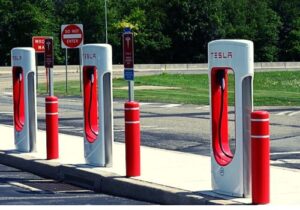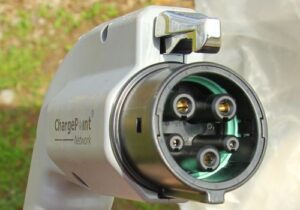Electric Vehicle Charging : Everything You Need To Know As A Beginner
Electric Vehicle charging is perhaps the most frustrating aspect of Electric Vehicle ownership, and even after driving the Model 3 for 20,000 miles and over a year and a half, there are still some aspects that confuse me, like as the varied power levels. If you’re coming from a gas automobile where everything is quite uniform, the power level, such as different plugs, different appearing stations, and so on, might be very perplexing.
This article should help you whether you are a new Electric Vehicle owner or wanting to make the switch to an electric vehicle.
I’m not going to get too technical, just a quick summary of charging, but if that’s something you’d like to see, let me know in the comments.
How Are Electric Vehicles Charged?

Electric vehicles must be charged using some type of Electric Vehicle charging equipment, which can be referred to as Electric Vehicle chargers, charging stations, charging points, or, more formally, EVSE, which stands for Electric Vehicle Supply Equipment. All of these terms refer to the same thing; it is simply a piece of technology that takes power from the grid and adapts it so that it can charge your car.
These may be found anywhere, from highway exits to shopping centers to parks, and even at home. In fact, all EVs sold come with a small piece of charging equipment that allows you to charge your car at home using a standard wall socket. But, before we get there, let’s take a step back.
ALSO READ THIS : The Best 7 Newest Electric Car
Do you Know the Power Level of Charging?

All of these chargers are normally divided into several charging power levels; the greater the power level, the more electricity it requires and the faster it will charge your automobile. Power is measured in kilowatts, which is the standard unit of measurement for energy. More kilowatts = faster charging.
I’ll also mention some charge times for these various power levels, but keep in mind that it changes by car, your state of charge, and different climatic factors that will vary by vehicle, and these numbers are based only on my experience with
my Model 3.
Charging Level One : L1
Level one is slow charging; you’ll get roughly one kilowatt of power, which isn’t much for charging something as large as a car. When I drip charge with my Model 3 it takes around 20 hours to add 100 miles of range usually at a rate of about 5 miles of range per hour which means a full charge will take over 60 hours which is not very fast but if you aren’t driving a ton you can easily add 40 to 50 miles overnight and have enough to drive the next day.
As stated previously, all EVs come with a little level one charger in the car that allows you to charge from a standard wall outlet, however it will be quite slow, which is where level two charging comes in.
Charging Level Two : L2
Level two is medium speed charging, which is commonly reduced as l2 or referred to as a destination charger because these are typically found at your destination when traveling to a location such as a hotel or a park. This is also the power level that the majority of Electric Vehicle drivers have in their homes since it finds a nice balance between cost and charging speed.
The power levels for these chargers range from four kilowatts to twenty kilowatts, but you’ll most typically see seven kilowatt chargers because it’s the same power that most high-powered appliances, such as your dryer, run on, and it’s also what most utilities are built up to handle. My Model 3 normally adds roughly 25 miles of range every hour on these level 2 chargers, which means you can add 100 miles of range in four hours and get a complete charge in 12 hours.
This is why, once again, I recommend upgrading from the stock charger that comes with the car. Even if you drive 250 miles per day in an Electric Vehicle with a range of 300 miles, you’ll easily be able to replace that range overnight.
Charging Level 3 DCFC : L3
There is one additional charging level, and that is DC fast charging. This is occasionally referred to as a level 3 charger, but I usually hear DCFC, which stands for Direct Current Fast Charging. However, you may also hear high-power DC charging. All of these terms refer to the same thing: ultra fast chargers ranging from 50 to 350 kilowatts, or loads of electricity that can charge you up quickly.
These are the chargers you’ll need on the road for any distance longer than your car’s range, thus if your car has a 300 mile range, you’ll probably have to stop for a DC fast charging stop if you want to travel 400 miles.
Many various organizations and networks are working on expanding our DCFC infrastructure, but for the time being, there are hundreds of highway routes all across the US with charging infrastructure to make long-distance travel and Electric Vehicle easier.
These are your superchargers lex fry America chargers, and they are usually significantly larger in size, about the size of a refrigerator, making them easier to spot. I believe that charging at levels one and two is very simple, but at level three, DC rapid charging, things can become a little more tricky because power levels, those kilowatt levels, can be limited by either the charger or the car itself.
My car can handle up to 250 kilowatt charging, but most of the chargers I visit only top out at 150 kilowatts, therefore that is the most amount of power that my car will be able to pull when I’m plugged into those stations. However, if I am driving a car that can only manage 100 kilowatt charging rates and plug into a station that can generate 150 kilowatts, my car will be limited to 100 kilowatts.
Because it can’t handle any more power than that, and higher power levels mean faster charging, so if you and your friend are both driving electric vehicles and you both pull up to 150 kilowatt stations but one car can only take, say, 50 kilowatts but your friend can take 150, they will charge a lot faster than you and be done sooner than you in the 50 kilowatt car.
If you’re looking for an Electric Vehicle and want a recommendation on a power level for your car, I’d recommend anything above 100 kilowatts, or even 150 if you’re able to. Most cars on the market now that are coming to market are above that rate and can handle that higher power, but some of them can’t, so check into that before buying.
When you charge at rates above 100 kilowatts, you get those extremely fast charging stops that are 15 to 30 minutes vs 45 to an hour, and in my experience, stopping at superchargers that even top out at 150 kilowatts, I only stop for a maximum of 30 minutes and most stops are only 15 minutes. But I think the most important thing to realize about fast charging is that it is only required if you travel outside the range of your electric vehicle, which for many of us is not very often because we just use our cars to get to work, get around town, and do activities near to home.
Aside from charge levels and charging speeds, there are also different plug types to be aware of if you plan to move to an electric vehicle.
Types of Charging Plugs :
To begin, there are just three basic plug kinds, and all you really need to know is what will work with your automobile; you don’t need to be an expert on all of them.
First, the SAE J1772 :

A super complicated name, but you’ll probably hear it referred to as a j plug but it looks like this and you can see an accompanying port on almost every other car except Tesla’s. Fortunately, Tesla cars include a little adapter that allows you to use these stations that simply pops onto the end of the port. The sole drawback to this plug type is that it cannot perform dc fast charging and is only capable of charging at levels one and two.
Second, the CCS :

The CCS appears identical to the J plug since it uses the same port, but has two additional contacts at the bottom of the handle for higher power charging. Most cars with this plug type will have a small port for the J plug and a small flap that you can flip down to do greater powered charging. There is also the CHAdeMO plug for fast charging, however this is gradually becoming obsolete with few vehicles even including it anymore, and the difference here is that it only does DC fast charging, not levels one or two.
CHAdeMO Plug :
A Nissan leaf is a very common one that is out there a lot has the J plug for levels one and two but then we’ll also have the CHAdeMO plug for level three

Then there’s the Tesla connector, which thankfully supports all three charging levels, but if I want to charge at a non-tesla station, I’ll need an adapter. Fortunately, there is one included with the car for that plug, so I can plug in at most public level 2 stations. You can purchase an adapter for the CHAdeMO plug, but I generally don’t recommend it because superchargers are so common, and there is currently no official Tesla adapter for the ccs plugs that do exist.
Conclusion:
If you’re new to EVs or just starting to do your research and came across this article, it’s probably a little overwhelming, but I’ll tell you that once you find your charging routine, as I like to call it, charging becomes exponentially easier. You find out that oh, I can just plug in at home, I don’t need to charge anywhere else if I’m just driving around town or oh, I need to go visit family in this one location
I’m someone that takes a lot of journeys that are quite similar very frequently. I’m not taking a lot of strange weird travels to a lot of different areas. I know where I need to stop to charge or know that I can make it there on one charge. Again, you don’t need to be an expert on all of these different plug kinds, power levels, or anything else once you understand what works with your car and how fast it charges.
In some areas, electricity costs are higher at particular times of the day, so you may be overpaying for electricity when your Tesla is charging. There is an online app that connects to your Tesla account and allows you to plan charging to take advantage of lower electricity rates overnight.
For example, if you come home from work and plug in your car, you may be paying peak rates for a few hours before everyone goes to bed, and those rates will drop back down if you use the Online app, which will automatically start and stop charging when rates are low, ensuring you pay the least amount possible to charge your car.
All you have to do is set your desired state of charge when you want to leave, and the app will take care of the rest.
